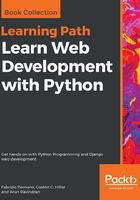
Iterating over multiple sequences
Let's see another example of how to iterate over two sequences of the same length, in order to work on their respective elements in pairs. Say we have a list of people and a list of numbers representing the age of the people in the first list. We want to print a pair person/age on one line for all of them. Let's start with an example and let's refine it gradually:
# multiple.sequences.py
people = ['Conrad', 'Deepak', 'Heinrich', 'Tom']
ages = [29, 30, 34, 36]
for position in range(len(people)):
person = people[position]
age = ages[position]
print(person, age)
By now, this code should be pretty straightforward for you to understand. We need to iterate over the list of positions (0, 1, 2, 3) because we want to retrieve elements from two different lists. Executing it we get the following:
$ python multiple.sequences.py
Conrad 29
Deepak 30
Heinrich 34
Tom 36
This code is both inefficient and not Pythonic. It's inefficient because retrieving an element given the position can be an expensive operation, and we're doing it from scratch at each iteration. The postal worker doesn't go back to the beginning of the road each time they deliver a letter, right? They move from house to house. From one to the next one. Let's try to make it better using enumerate:
# multiple.sequences.enumerate.py
people = ['Conrad', 'Deepak', 'Heinrich', 'Tom']
ages = [29, 30, 34, 36]
for position, person in enumerate(people):
age = ages[position]
print(person, age)
That's better, but still not perfect. And it's still a bit ugly. We're iterating properly on people, but we're still fetching age using positional indexing, which we want to lose as well. Well, no worries, Python gives you the zip function, remember? Let's use it:
# multiple.sequences.zip.py
people = ['Conrad', 'Deepak', 'Heinrich', 'Tom']
ages = [29, 30, 34, 36]
for person, age in zip(people, ages):
print(person, age)
Ah! So much better! Once again, compare the preceding code with the first example and admire Python's elegance. The reason I wanted to show this example is twofold. On the one hand, I wanted to give you an idea of how shorter code in Python can be compared to other languages where the syntax doesn't allow you to iterate over sequences or collections as easily. And on the other hand, and much more importantly, notice that when the for loop asks zip(sequenceA, sequenceB) for the next element, it gets back a tuple, not just a single object. It gets back a tuple with as many elements as the number of sequences we feed to the zip function. Let's expand a little on the previous example in two ways, using explicit and implicit assignment:
# multiple.sequences.explicit.py
people = ['Conrad', 'Deepak', 'Heinrich', 'Tom']
ages = [29, 30, 34, 36]
nationalities = ['Poland', 'India', 'South Africa', 'England']
for person, age, nationality in zip(people, ages, nationalities):
print(person, age, nationality)
In the preceding code, we added the nationalities list. Now that we feed three sequences to the zip function, the for loop gets back a three-tuple at each iteration. Notice that the position of the elements in the tuple respects the position of the sequences in the zip call. Executing the code will yield the following result:
$ python multiple.sequences.explicit.py
Conrad 29 Poland
Deepak 30 India
Heinrich 34 South Africa
Tom 36 England
Sometimes, for reasons that may not be clear in a simple example such as the preceding one, you may want to explode the tuple within the body of the for loop. If that is your desire, it's perfectly possible to do so:
# multiple.sequences.implicit.py
people = ['Conrad', 'Deepak', 'Heinrich', 'Tom']
ages = [29, 30, 34, 36]
nationalities = ['Poland', 'India', 'South Africa', 'England']
for data in zip(people, ages, nationalities):
person, age, nationality = data
print(person, age, nationality)
It's basically doing what the for loop does automatically for you, but in some cases you may want to do it yourself. Here, the three-tuple data that comes from zip(...) is exploded within the body of the for loop into three variables: person, age, and nationality.